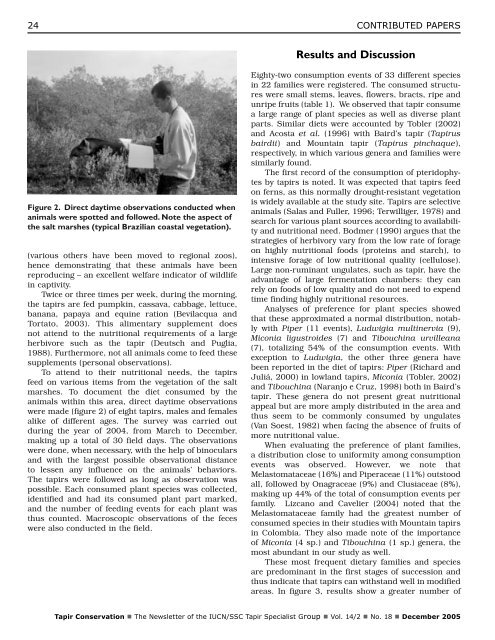Tapir Conservation - Tapir Specialist Group
Tapir Conservation - Tapir Specialist Group
Tapir Conservation - Tapir Specialist Group
You also want an ePaper? Increase the reach of your titles
YUMPU automatically turns print PDFs into web optimized ePapers that Google loves.
24<br />
Figure 2. Direct daytime observations conducted when<br />
animals were spotted and followed. Note the aspect of<br />
the salt marshes (typical Brazilian coastal vegetation).<br />
(various others have been moved to regional zoos),<br />
hence demonstrating that these animals have been<br />
reproducing – an excellent welfare indicator of wildlife<br />
in captivity.<br />
Twice or three times per week, during the morning,<br />
the tapirs are fed pumpkin, cassava, cabbage, lettuce,<br />
banana, papaya and equine ration (Bevilacqua and<br />
Tortato, 2003). This alimentary supplement does<br />
not attend to the nutritional requirements of a large<br />
herbivore such as the tapir (Deutsch and Puglia,<br />
1988). Furthermore, not all animals come to feed these<br />
supplements (personal observations).<br />
To attend to their nutritional needs, the tapirs<br />
feed on various items from the vegetation of the salt<br />
marshes. To document the diet consumed by the<br />
animals within this area, direct daytime observations<br />
were made (figure 2) of eight tapirs, males and females<br />
alike of different ages. The survey was carried out<br />
during the year of 2004, from March to December,<br />
making up a total of 30 field days. The observations<br />
were done, when necessary, with the help of binoculars<br />
and with the largest possible observational distance<br />
to lessen any influence on the animals’ behaviors.<br />
The tapirs were followed as long as observation was<br />
possible. Each consumed plant species was collected,<br />
identified and had its consumed plant part marked,<br />
and the number of feeding events for each plant was<br />
thus counted. Macroscopic observations of the feces<br />
were also conducted in the field.<br />
CONTRIBUTED PAPERS<br />
Results and Discussion<br />
Eighty-two consumption events of 33 different species<br />
in 22 families were registered. The consumed structures<br />
were small stems, leaves, flowers, bracts, ripe and<br />
unripe fruits (table 1). We observed that tapir consume<br />
a large range of plant species as well as diverse plant<br />
parts. Similar diets were accounted by Tobler (2002)<br />
and Acosta et al. (1996) with Baird’s tapir (<strong>Tapir</strong>us<br />
bairdii) and Mountain tapir (<strong>Tapir</strong>us pinchaque),<br />
respectively, in which various genera and families were<br />
similarly found.<br />
The first record of the consumption of pteridophytes<br />
by tapirs is noted. It was expected that tapirs feed<br />
on ferns, as this normally drought-resistant vegetation<br />
is widely available at the study site. <strong>Tapir</strong>s are selective<br />
animals (Salas and Fuller, 1996; Terwilliger, 1978) and<br />
search for various plant sources according to availability<br />
and nutritional need. Bodmer (1990) argues that the<br />
strategies of herbivory vary from the low rate of forage<br />
on highly nutritional foods (proteins and starch), to<br />
intensive forage of low nutritional quality (cellulose).<br />
Large non-ruminant ungulates, such as tapir, have the<br />
advantage of large fermentation chambers: they can<br />
rely on foods of low quality and do not need to expend<br />
time finding highly nutritional resources.<br />
Analyses of preference for plant species showed<br />
that these approximated a normal distribution, notably<br />
with Piper (11 events), Ludwigia multinervia (9),<br />
Miconia ligustroides (7) and Tibouchina urvilleana<br />
(7), totalizing 54% of the consumption events. With<br />
exception to Ludwigia, the other three genera have<br />
been reported in the diet of tapirs: Piper (Richard and<br />
Juliá, 2000) in lowland tapirs, Miconia (Tobler, 2002)<br />
and Tibouchina (Naranjo e Cruz, 1998) both in Baird’s<br />
tapir. These genera do not present great nutritional<br />
appeal but are more amply distributed in the area and<br />
thus seem to be commonly consumed by ungulates<br />
(Van Soest, 1982) when facing the absence of fruits of<br />
more nutritional value.<br />
When evaluating the preference of plant families,<br />
a distribution close to uniformity among consumption<br />
events was observed. However, we note that<br />
Melastomataceae (16%) and Piperaceae (11%) outstood<br />
all, followed by Onagraceae (9%) and Clusiaceae (8%),<br />
making up 44% of the total of consumption events per<br />
family. Lizcano and Cavelier (2004) noted that the<br />
Melastomataceae family had the greatest number of<br />
consumed species in their studies with Mountain tapirs<br />
in Colombia. They also made note of the importance<br />
of Miconia (4 sp.) and Tibouchina (1 sp.) genera, the<br />
most abundant in our study as well.<br />
These most frequent dietary families and species<br />
are predominant in the first stages of succession and<br />
thus indicate that tapirs can withstand well in modified<br />
areas. In figure 3, results show a greater number of<br />
<strong>Tapir</strong> <strong>Conservation</strong> n The Newsletter of the IUCN/SSC <strong>Tapir</strong> <strong>Specialist</strong> <strong>Group</strong> n Vol. 14/2 n No. 18 n December 2005










